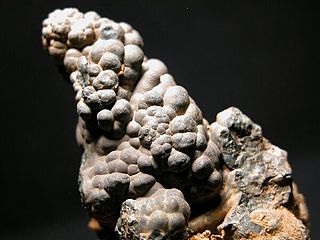
A perovskite is any material with the same type of crystal structure as calcium titanium oxide (CaTiO3), known as the perovskite structure, or XIIA2+VIB4+X2−3 with the oxygen in the edge centers. Perovskites take their name from the mineral, which was first discovered in the Ural mountains of Russia by Gustav Rose in 1839 and is named after Russian mineralogist L. A. Perovski (1792–1856). The general chemical formula for perovskite compounds is ABX3, where 'A' and 'B' are two cations of very different sizes, and X is an anion that bonds to both. The 'A' atoms are larger than the 'B' atoms. The ideal cubic structure has the B cation in 6-fold coordination, surrounded by an octahedron of anions, and the A cation in 12-fold cuboctahedral coordination. The relative ion size requirements for stability of the cubic structure are quite stringent, so slight buckling and distortion can produce several lower-symmetry distorted versions, in which the coordination numbers of A cations, B cations or both are reduced.

Psilomelane is a group name for hard black manganese oxides including hollandite and romanechite. Psilomelane consists of hydrous manganese oxide with variable amounts of barium and potassium. Psilomelane is erroneously, and uncommonly, known as black hematite, despite not being related to true hematite, which is an iron oxide.
Manganese oxide is any of a variety of manganese oxides and hydroxides. These include
The Weldon process is a process developed in 1866 by Walter Weldon for recovering manganese dioxide for re-use in chlorine manufacture. Commercial operations started at the Gamble works in St. Helens in 1869. The process is describe in considerable detailed in the book, The Alkali Industry, by J.R. Partington,D.Sc.
A regenerative fuel cell or reverse fuel cell (RFC) is a fuel cell run in reverse mode, which consumes electricity and chemical B to produce chemical A. By definition, the process of any fuel cell could be reversed. However, a given device is usually optimized for operating in one mode and may not be built in such a way that it can be operated backwards. Standard fuel cells operated backwards generally do not make very efficient systems unless they are purpose-built to do so as with high-pressure electrolysers, regenerative fuel cells, solid-oxide electrolyser cells and unitized regenerative fuel cells.

In inorganic nomenclature, a manganate is any negatively charged molecular entity with manganese as the central atom. However, the name is usually used to refer to the tetraoxidomanganate(2−) anion, MnO2−
4, also known as manganate(VI) because it contains manganese in the +6 oxidation state. Manganates are the only known manganese(VI) compounds.
Electroceramics is a class of ceramic materials used primarily for their electrical properties.
Lanthanum carbonate, La2(CO3)3, is the salt formed by lanthanum(III) cations and carbonate anions. It is an ore of lanthanum metal, (Bastnäsite) along with monazite.
Lanthanum strontium cobalt ferrite (LSCF), also called lanthanum strontium cobaltite ferrite is a specific ceramic oxide derived from lanthanum cobaltite of the ferrite group. It is a phase containing lanthanum(III) oxide, strontium oxide, cobalt oxide and iron oxide.

Manganese(III) oxide is a chemical compound with the formula Mn2O3.
Potassium dimanganate(III), K6Mn2O6, is a manganese(III) compound. Unlike lithium and sodium manganites, MMnO2, which are best described as mixed oxides, potassium dimanganite contains discrete Mn2O6−
6 anions in the solid state. It rapidly hydrolyzes in air.

Cryptomelane is a potassium manganese oxide mineral with formula K(Mn4+,Mn2+)8O16.
LSAT is the most common name for the inorganic compound lanthanum aluminate - strontium aluminium tantalate, which has the chemical formula (LaAlO3)0.3(Sr2TaAlO6)0.7 or its less common alternative: (La0.18Sr0.82)(Al0.59Ta0.41)O3. LSAT is a hard, optically transparent ceramic oxide of the elements lanthanum, aluminum, strontium and tantalum. LSAT has the perovskite crystal structure, and its most common use is as a single crystal substrate for the growth of epitaxial thin films.
A complex oxide is a chemical compound that contains oxygen and at least two other elements. Complex oxide materials are notable for their wide range of magnetic and electronic properties, such as ferromagnetism, ferroelectricity, and high-temperature superconductivity. These properties often come from their strongly correlated electrons in d or f orbitals.
Nickel manganese oxides, or nickel manganates, are spinel structure compounds of Nickel, Manganese and Oxygen of the form: Ni(x)Mn(3-x)O(y)
This page is based on this
Wikipedia article Text is available under the
CC BY-SA 4.0 license; additional terms may apply.
Images, videos and audio are available under their respective licenses.






